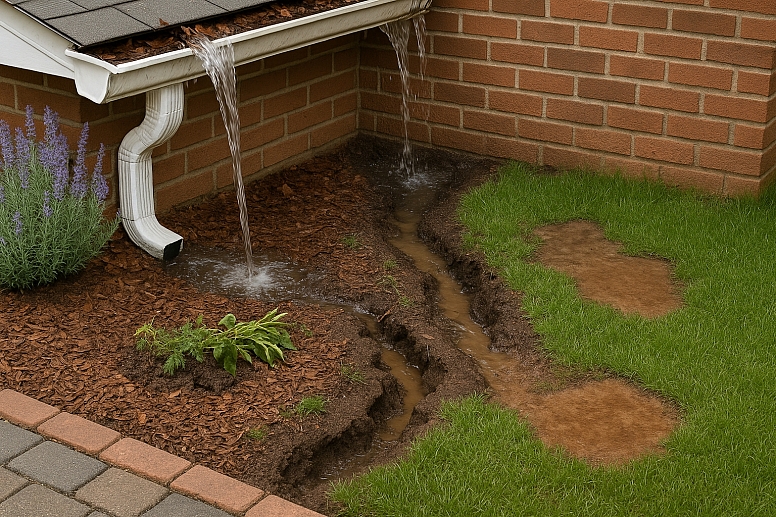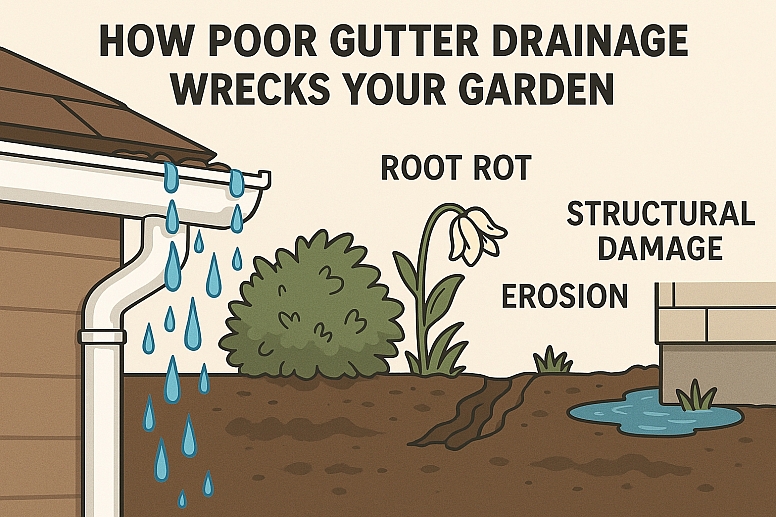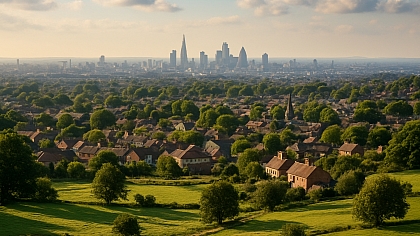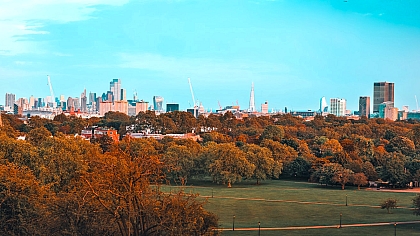
How Poor Gutter Drainage Affects Your Garden and Landscaping
In a city like London, where rainfall is frequent and gardens are often compact, the impact of poor gutter drainage is amplified. Many homeowners focus on creating that perfect urban oasis—raised beds, patio seating, even vertical gardens—without realising that a blocked or misaligned gutter can quietly undo it all.
Water runoff from a single heavy downpour can saturate soil, displace carefully laid gravel, and even lead to subsidence near basement flats. Whether you're in Islington with a tidy courtyard or tending a garden in Richmond, staying on top of your gutter maintenance isn’t just practical—it’s essential to protecting your outdoor investment.
Your gutters might seem like a minor detail, but they're the unsung heroes protecting your carefully curated outdoor space. When they fail, the consequences ripple through your garden in ways that'll make you question everything you thought you knew about property maintenance.
I've seen it happen countless times — homeowners focus on the perfect rose bed or that Instagram-worthy patio, completely ignoring the water management system above their heads. Then comes the first heavy downpour, and suddenly their prize-winning petunias are drowning whilst their prized lawn develops mysterious brown patches.

Water Damage to Plant Roots & Soil Structure
Poor gutter drainage creates a domino effect that starts underground. When water cascades uncontrolled from blocked or damaged gutters, it doesn't just disappear into the earth — it hammers the soil with tremendous force, compacting it beyond recognition.
Compacted soil becomes practically impermeable. Your plants' roots struggle to breathe, nutrients can't penetrate properly, and beneficial microorganisms start dying off. It's like suffocating your garden from below whilst drowning it from above.
The oversaturation doesn't discriminate either. Delicate annuals might rot within days, but even established perennials suffer. Root rot spreads quickly in waterlogged conditions, and once it takes hold, you're looking at significant plant losses. I remember watching a neighbour's mature lavender — which had survived harsh winters for years — succumb to root rot after just one season of poor drainage.
What's particularly frustrating is that the damage often goes unnoticed until it's too late. Plants don't immediately show stress from waterlogged roots; they decline gradually, leaving you scratching your head about what went wrong.
Erosion Problems That Reshape Your Garden
Uncontrolled water flow turns into a destructive force that reshapes your outdoor space. Where water pours from faulty gutters, you'll notice channels forming in your soil — not the gentle meandering paths you might create deliberately, but aggressive scars that deepen with each rainfall.
Topsoil gets washed away first because it's the lightest & richest layer. This is devastating because topsoil takes decades to develop naturally. You're watching years of soil building disappear down the drain (quite literally) with every storm.
The erosion doesn't stop at the soil either. Mulch gets scattered, gravel pathways develop ruts, and even small stones can be displaced. I've seen garden borders completely reshaped by persistent water flow — what started as neat, defined edges became uneven, chaotic messes.
Perhaps most concerning is how erosion affects slopes and retaining walls. Water undermines foundations, and structural damage follows. One friend discovered their decorative stone wall had shifted noticeably after a particularly wet winter; the culprit was overflow from a single blocked downpipe.
Foundation and Structural Risks
Your house foundation sits surprisingly close to your garden in most UK properties, and poor gutter drainage threatens both simultaneously. Water pooling against foundation walls doesn't just create damp problems inside — it affects the stability of adjacent garden structures too.
Patios, garden walls, and raised beds all depend on stable ground beneath them. When water constantly saturates the soil around these structures, settling becomes inevitable. Cracks appear, levels shift, and what seemed like solid construction starts looking decidedly wobbly.
The freeze-thaw cycle makes everything worse. Water trapped in saturated soil expands when temperatures drop, creating tremendous pressure against anything nearby. Garden steps crack, retaining walls bulge, and paving stones heave upward in strange patterns.
I've witnessed entire patio sections become unusable because of subsidence caused by poor water management. The homeowner spent thousands on beautiful natural stone, only to watch it buckle and crack because they ignored their guttering system.
Creating Unwanted Wet Zones
Some gardens benefit from bog gardens or water features, but only when they're planned & positioned correctly. Poor gutter drainage creates accidental wet zones in completely inappropriate locations — usually right where you want to walk or where your most valuable plants are located.
These unwanted wet areas become breeding grounds for all sorts of problems. Moss takes over previously healthy grass, creating slippery patches that are genuinely dangerous during winter months. The soil develops that distinctive sour smell of anaerobic conditions, and beneficial earthworms relocate to drier areas.
Wet zones also attract pests you'd rather avoid. Slugs love consistently damp areas, and they'll multiply rapidly in these conditions. Fungal diseases spread more easily in wet microclimates, affecting plants well beyond the immediate problem zone.
The visual impact is significant too. What should be a lush, green space becomes patchy and unhealthy-looking. Brown, waterlogged grass doesn't recover quickly, and bare patches develop where nothing can tolerate the excessive moisture.
Seasonal Plant Health Issues
Different seasons bring unique challenges when gutter drainage fails, but winter tends to be the most problematic. Plants that might survive occasional waterlogging during the growing season often can't cope with prolonged wet conditions when they're dormant.
Spring becomes particularly frustrating because new growth struggles to establish in waterlogged soil. Seeds won't germinate properly, young plants develop weak root systems, and even established plants produce fewer flowers and fruits than expected.
Summer heat combined with poor drainage creates its problems. Wet soil takes longer to warm up, delaying plant development. But paradoxically, when dry spells arrive, compacted soil from previous waterlogging makes it difficult for plants to access water efficiently.
Autumn leaf fall adds another complication. Wet areas can't be maintained properly — you can't rake leaves from soggy ground without damaging both the surface and the tools. Decomposing leaves in waterlogged conditions create anaerobic decomposition, which smells unpleasant & depletes soil oxygen further.
Professional Solutions and Maintenance
Addressing gutter drainage problems requires both immediate fixes and long-term prevention strategies. The most obvious starting point is ensuring your gutters actually function as designed — clear blockages, repair leaks, and verify that downpipes direct water away from vulnerable areas.
But sometimes the solution involves more than basic maintenance. Installing additional drainage systems, creating proper soakaways, or even regrading problem areas might be necessary to protect valuable plants and structures.
I used Gutter Guys when my property developed serious drainage issues, and they were brilliant at identifying problems I hadn't even noticed. Their assessment revealed that what I thought was just a minor blockage was a design flaw in how the original guttering system had been installed.
Regular professional maintenance makes a huge difference. Annual inspections catch problems before they cause garden damage, and proper cleaning prevents the buildup that leads to overflow situations. It's much cheaper than replacing plants, repairing erosion damage, or fixing structural problems after they develop.
Prevention Strategies for Garden Protection
Smart garden design can mitigate some drainage problems even when guttering isn't perfect. Creating proper drainage channels, installing French drains in vulnerable areas, and choosing plants that can tolerate occasional wet conditions all help build resilience into your outdoor space.
Mulching becomes even more important when drainage is a concern. Organic mulches help absorb excess water whilst protecting soil structure from heavy rainfall impact. They also improve soil drainage over time as they decompose and add organic matter.
Consider installing rain barrels or water collection systems that redirect overflow away from sensitive garden areas. These serve the dual purpose of conserving water for dry periods whilst preventing damage during wet spells.
Raised beds offer another solution for areas prone to waterlogging. They provide better drainage for plants whilst reducing soil compaction from foot traffic on wet ground. Even modest height increases — just 15-20cm — can make a significant difference to plant health.
Your gutters and your garden are more connected than most people realise. Neglecting one inevitably affects the other, often in expensive and frustrating ways that could have been easily prevented.
The good news is that addressing drainage problems usually involves straightforward solutions rather than complex engineering projects. Regular maintenance, prompt repairs, and thoughtful garden design can prevent most water-related damage before it starts affecting your plants and outdoor structures.
Don't wait until you notice problems — by then, damage has already begun. A proactive approach to gutter maintenance protects your investment in both your property and your garden, ensuring that your outdoor space remains the sanctuary you intended rather than becoming a source of constant frustration.











